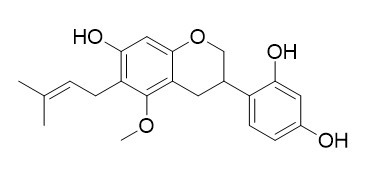Glyasperin C
Glyasperin C acts as a partial estrogen antagonist, it shows tyrosinase inhibitory activity (IC (50) = 0.13 +/- 0.01 microg/mL), it could be a promising candidate in the design of skin-whitening agents. Glyasperin C shows potent anti-vancomycin-resistant Enterococci effects (MIC 1.9 × 10-5-4.5 × 10-5 M for E. faecium and E. faecalis).
Inquire / Order:
manager@chemfaces.com
Technical Inquiries:
service@chemfaces.com
Tel:
+86-27-84237783
Fax:
+86-27-84254680
Address:
1 Building, No. 83, CheCheng Rd., Wuhan Economic and Technological Development Zone, Wuhan, Hubei 430056, PRC
Providing storage is as stated on the product vial and the vial is kept tightly sealed, the product can be stored for up to
24 months(2-8C).
Wherever possible, you should prepare and use solutions on the same day. However, if you need to make up stock solutions in advance, we recommend that you store the solution as aliquots in tightly sealed vials at -20C. Generally, these will be useable for up to two weeks. Before use, and prior to opening the vial we recommend that you allow your product to equilibrate to room temperature for at least 1 hour.
Need more advice on solubility, usage and handling? Please email to: service@chemfaces.com
The packaging of the product may have turned upside down during transportation, resulting in the natural compounds adhering to the neck or cap of the vial. take the vial out of its packaging and gently shake to let the compounds fall to the bottom of the vial. for liquid products, centrifuge at 200-500 RPM to gather the liquid at the bottom of the vial. try to avoid loss or contamination during handling.
Am J Chin Med.2016, 44(8):1719-1735
Plants (Basel).2023, 12(11):2107.
Appl. Sci.2022, 12(4), 2032.
J Food Biochem.2020, 44(6):e13198.
Biomed Pharmacother.2024, 171:116166.
Nutr Res Pract.2020, 14(5):478-489.
Journal of Phytopathology2021, 169,Issue11-12.
Metabolites.2023, 13(5):625.
Front Pharmacol.2021, 12:652860.
Evid Based Complement Alternat Med.2021, 2021:5319584.
Related and Featured Products
Steroids. 2016 Jan;105:42-9.
Licorice root components in dietary supplements are selective estrogen receptor modulators with a spectrum of estrogenic and anti-estrogenic activities.[Pubmed:
26631549 ]
Licorice root extracts are often consumed as botanical dietary supplements by menopausal women as a natural alternative to pharmaceutical hormone replacement therapy. In addition to their components liquiritigenin (Liq) and isoliquiritigenin (Iso-Liq), known to have estrogenic activity, licorice root extracts also contain a number of other flavonoids, isoflavonoids, and chalcones.
METHODS AND RESULTS:
We have investigated the estrogenic activity of 7 of these components, obtained from an extract of Glycyrrhiza glabra powder, namely Glabridin (L1), Calycosin (L2), Methoxychalcone (L3), Vestitol (L4), Glyasperin C (L5), Glycycoumarin (L6), and Glicoricone (L7), and compared them with Liq, Iso-Liq, and estradiol (E2). All components, including Liq and Iso-Liq, have low binding affinity for estrogen receptors (ERs). Their potency and efficacy in stimulating the expression of estrogen-regulated genes reveal that Liq and Iso-Liq and L2, L3, L4, and L6 are estrogen agonists. Interestingly, L3 and L4 have an efficacy nearly equivalent to E2 but with a potency ca. 10,000-fold less. The other components, L1, L5 and L7, acted as partial estrogen antagonists. All agonist activities were reversed by the antiestrogen, ICI 182,780, or by knockdown of ERα with siRNA, indicating that they are ER dependent. In HepG2 hepatoma cells stably expressing ERα, only Liq, Iso-Liq, and L3 stimulated estrogen-regulated gene expression, and in all cases gene stimulation did not occur in HepG2 cells lacking ERα.
CONCLUSIONS:
Collectively, these findings classify the components of licorice root extracts as low potency, mixed ER agonists and antagonists, having a character akin to that of selective estrogen receptor modulators or SERMs.
Molecules. 2014 Aug 25;19(9):13027-41.
Structures of new phenolics isolated from licorice, and the effectiveness of licorice phenolics on vancomycin-resistant Enterococci.[Pubmed:
25157467]
Licorice, which is the underground part of Glycyrrhiza species, has been used widely in Asian and Western countries as a traditional medicine and as a food additive.
METHODS AND RESULTS:
Our continuous investigation on the constituents of roots and stolons of Glycyrrhiza uralensis led to the isolation of two new phenolics, in addition to 14 known compounds. Structural studies including spectroscopic and simple chemical derivatizations revealed that both of the new compounds had 2-aryl-3-methylbenzofuran structures. An examination of the effectiveness of licorice phenolics obtained in this study on vancomycin-resistant strains Enterococcus faecium FN-1 and Enterococcus faecalis NCTC12201 revealed that licoricidin showed the most potent antibacterial effects against both of E. faecalis and E. faecium with a minimum inhibitory concentration (MIC) of 1.9 × 10-5 M. 8-(γ,γ-Dimethylallyl)-wighteone, isoangustone A, 3'-(γ,γ-dimethylallyl)-kievitone, Glyasperin C, and one of the new 3-methyl-2-phenylbenzofuran named neoglycybenzofuran also showed potent anti-vancomycin-resistant Enterococci effects (MIC 1.9 × 10-5-4.5 × 10-5 M for E. faecium and E. faecalis).
CONCLUSIONS:
The HPLC condition for simultaneous detection of the phenolics in the extract was investigated to assess the quality control of the natural antibacterial resource, and quantitative estimation of several major phenolics in the extract with the established HPLC condition was also performed. The results showed individual contents of 0.08%-0.57% w/w of EtOAc extract for the major phenolics in the materials examined.
Planta Med. 2005 Aug;71(8):785-7.
Identification of tyrosinase inhibitors from Glycyrrhiza uralensis.[Pubmed:
16142649 ]
Tyrosinase is a key enzyme in the production of melanins.
METHODS AND RESULTS:
Phytochemical studies of a Glycyrrhiza uralensis extract were performed by measuring the tyrosinase and melanin synthesis inhibitory activity. Glycyrrhisoflavone and Glyasperin C were identified as tyrosinase inhibitors for the first time. Glyasperin C showed a stronger tyrosinase inhibitory activity (IC (50) = 0.13 +/- 0.01 microg/mL) than glabridin (IC (50) = 0.25 +/- 0.01 microg/mL) and a moderate inhibition of melanin production (17.65 +/- 8.8 % at 5 microg/mL). Glycyrrhisoflavone showed a strong melanin synthesis inhibitory activity (63.73 +/- 6.8 % inhibition at 5 microg/mL).
CONCLUSIONS:
These results suggest that Glyasperin C and glycyrrhisoflavone could be promising candidates in the design of skin-whitening agents.



